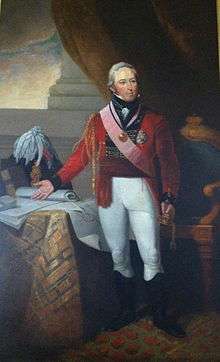John Coape Sherbrooke

General Sir John Coape Sherbrooke, GCB (baptised 29 April 1764 – 14 February 1830) was a British soldier and colonial administrator. After serving in the British army in Nova Scotia, the Netherlands, India, the Mediterranean (including Sicily), and Spain, he was appointed Lieutenant-Governor of Nova Scotia in 1811. During the War of 1812, his policies and victory in the conquest of present-day Maine, renaming it the colony of New Ireland, led to significant prosperity in Nova Scotia.
Spain
He served under the Duke of Wellington as a Major General in the Peninsular War from 1807 until his reassignment to Nova Scotia. Simultaneously, he was a Lieutenant General of Portuguese forces.[1]
Nova Scotia
Sherbrooke arrived at Halifax on 16 October 1812 as commander of the forces in the Atlantic provinces. The five years of Sherbrooke’s administration were dominated by war with the United States, which broke out in June 1812, and matters relating to the colony’s defence. He mounted guns at harbour entrances across the colony and placed the militias in a state of readiness. The war proved to be profitable for Nova Scotia. Sherbrooke’s commercial policies turned the Atlantic provinces into a thriving entrepôt for international trade.[2]
From 1813–1830 Sherbrooke was Colonel of the 33rd Regiment of Foot.[3]
New Ireland
Deciding to strike at the long-disputed borderland between Passamaquoddy Bay and the Penobscot River, Sherbrooke led an expeditionary force that August which successfully landed at Castine and proceeded to subdue the entire region between the Penobscot and the St Croix. He renamed the region the colony of New Ireland. The eight-month occupation of Castine yielded customs revenues which were subsequently used to finance the Cambridge Military Library[4] in Halifax and found Dalhousie College.[5]
The financing of Dalhousie college, now Dalhousie University in Halifax had largely come from custom duties collected by Sir John Coape Sherbrooke, then lieutenant-governor of Nova Scotia during the occupation of Castine, Maine during the War of 1812, investing £7000 as the initial endowment and £3000 reserved for the actual construction of the college.[6]
British North America
His active defence of the colony during the War of 1812 led to his appointment as Governor General of British North America in 1816. His talent as a mediator helped settle disputes, and he won the confidence of Louis-Joseph Papineau.
Ill health (probably a stroke) forced Sherbrooke to resign after only two years, and he retired to Nottinghamshire in England. However, his brief tenure was remembered as a period of calm before the coming storm (see Rebellions of 1837).
While he resided in Nova Scotia, his home was at Birch Cove on Bedford Basin, near Halifax.[7] Named Sherwood, it eventually lent its name to the neighbourhoods of Sherwood Park and Sherwood Heights. The community of Sherbrooke, Nova Scotia also bears his name.[8] Other honorific eponyms are listed below.
Honorific eponyms
- Geographic locations
-
 Nova Scotia: Sherbrooke
Nova Scotia: Sherbrooke -
 Nova Scotia: New Ross, formerly known as Sherbrooke
Nova Scotia: New Ross, formerly known as Sherbrooke -
 Quebec: Sherbrooke
Quebec: Sherbrooke -
 Quebec: Rue Sherbrooke, Montreal
Quebec: Rue Sherbrooke, Montreal
- Buildings
-
 Quebec: Sherbrooke Station, Montreal
Quebec: Sherbrooke Station, Montreal - Sherbrooke Martello Tower (1814–1828; four guns), at McNabs Cove, opposite York Redoubt at Halifax harbour.
- Fort Sherbrooke (Maine)
- Vessels
See also
External links
References
- ↑
- ↑ http://www.biographi.ca/009004-119.01-e.php?&id_nbr=3132
- ↑ of Wellington's regimental website, Colonels of The Regiment
- ↑ http://www.halifaxpubliclibraries.ca/research/topics/local-history-genealogy/literary-walking-tour/tour-stop-14.html
- ↑ http://www.biographi.ca/009004-119.01-e.php?&id_nbr=3132
- ↑ The Project Gutenberg EBook of The Makers of Canada: Index and Dictionary of Canadian History, by Various 2010
- ↑ Dawson, Joan (2007). The Mapmaker's Legacy: Nineteenth century Nova Scotia through maps. Nimbus. pp. 44–45. ISBN 9781551096070.
- ↑ Bruce Fergusson (1967). Place names of Nova Scotia, p. 620
| Government offices | ||
|---|---|---|
| Preceded by Alexander Croke |
Lieutenant Governor of Nova Scotia 1811–1816 |
Succeeded by George Stracey Smyth |
| Preceded by Sir George Prevost |
Governor General of British North America 1816–1818 |
Succeeded by The Duke of Richmond |
| Military offices | ||
| Preceded by Sir Thomas Trigge |
Colonel of the 68th (Durham) Regiment of Foot (Light Infantry) 1809–1813 |
Succeeded by Sir Henry Warde |